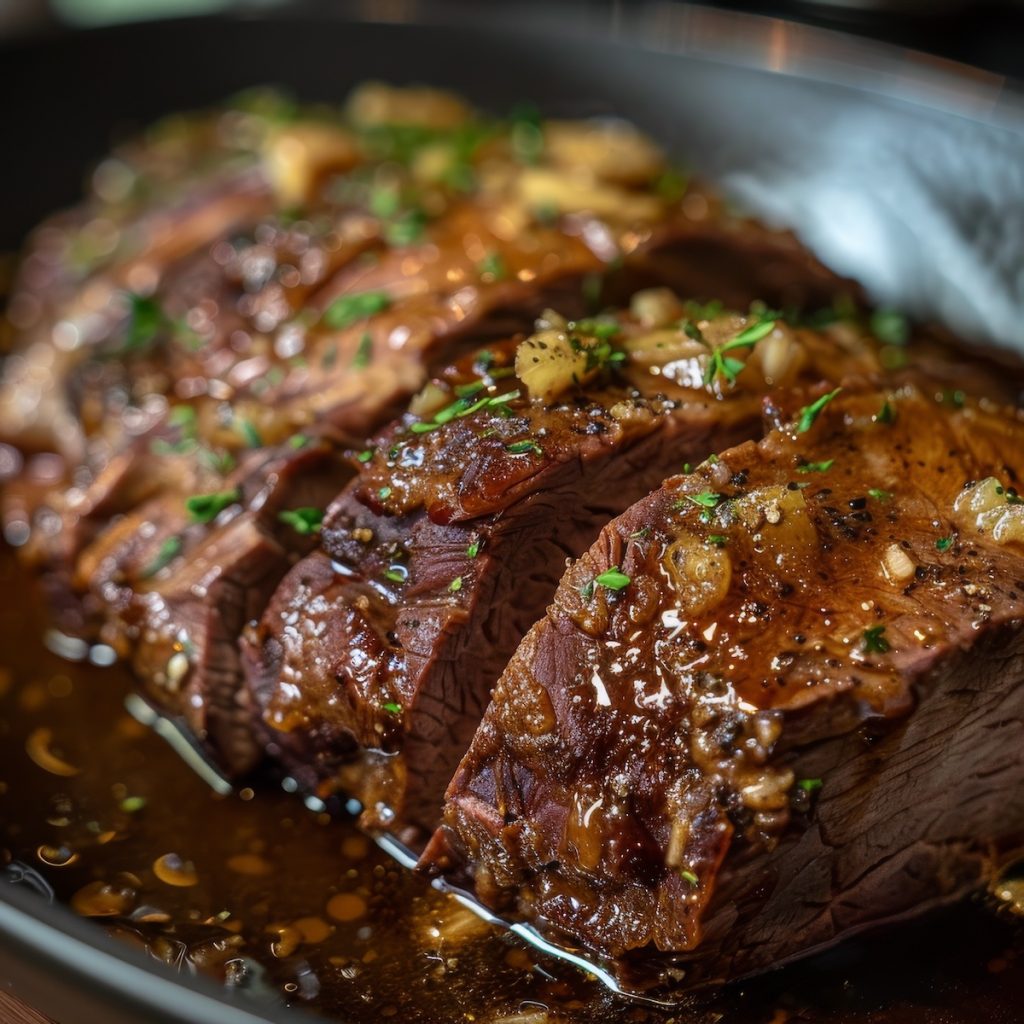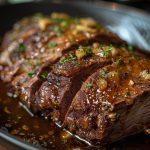How to Cook an American Buffalo Roast
Buffalo meat, also known as buffalo beef or simply buffalo, is meat derived from buffalo, the American bison (Bison bison). The term “buffalo” can sometimes be confusing because in North America, “buffalo” commonly refers to the American bison.
American bison meat is considered a lean and flavorful alternative to beef. It is popular in North America and is often used in burgers, steaks, and roasts. Both types of buffalo meat are valued for their rich flavor, tenderness, and relatively low-fat content compared to beef.
What Does Buffalo Taste Like?
American bison meat, often called bison, has a distinct and rich flavor that is often described as slightly sweeter and richer than beef. The taste of bison meat can vary depending on factors such as the age of the animal, its diet, and how it’s prepared. However, in general, bison meat is known for its:
- Richness: Bison meat has a pronounced richness that comes from its marbling and the grassy diet many bison are raised on. This richness contributes to its flavor profile and makes it quite satisfying.
- Slight Sweetness: Many people find bison meat to be slightly sweet, which adds to its appeal and sets it apart from beef.
- Lean Texture: Bison meat is leaner than beef, which means it tends to be slightly firmer and less fatty. However, it can still be quite tender and juicy when cooked properly.
- Some describe bison meat as having earthy undertones, which can add complexity to its flavor profile.
Bison meat is prized for its unique taste, tenderness, and health benefits. It’s often considered a gourmet option and is enjoyed in various culinary preparations, from burgers and steaks to roasts and stews.
Wild or Farm Raised?
American buffalo meat, also known as bison meat, is primarily farm-raised rather than wild-caught. While bison historically roamed across large parts of North America in the wild, the vast majority of bison meat available today comes from bison raised on farms and ranches.
Bison ranching has become common, particularly in North America, where bison are raised for their meat, hides, and other products. These ranches typically manage herds of bison in a controlled environment, providing them access to pastureland or forage and ensuring their health and well-being. Bison are generally raised like cattle, with attention paid to their diet, living conditions, and veterinary care.
That said, there are still wild populations of bison in certain parts of North America, primarily in national parks and protected areas. However, the meat from these wild populations is not commonly available for commercial sale and is subject to strict regulations and conservation efforts to protect wild bison populations. Therefore, most bison meat available for consumption is sourced from farm-raised animals.
Nutrition
Buffalo meat, or bison meat, is highly nutritious and offers several health benefits. Here are some key nutritional aspects of bison meat:
- Protein: Bison meat is a rich source of high-quality protein, which is essential for building and repairing tissues, supporting muscle health, and maintaining overall bodily functions.
- Low in Fat: Bison meat is typically leaner than beef and has a lower fat content. It’s often recommended for individuals looking to reduce their saturated fats and cholesterol intake. The lean nature of bison meat makes it a suitable option for those following low-fat or low-calorie diets.
- Lower in Calories: Due to its lower fat content, bison meat tends to be lower in calories than beef. This can make it a good choice for individuals watching their calorie intake.
- Rich in Nutrients: Bison meat is a good source of essential nutrients such as iron, zinc, selenium, and B vitamins (including vitamin B12, niacin, and riboflavin). These nutrients are important in various bodily functions, including energy metabolism, immune function, and red blood cell production.
- Omega-3 Fatty Acids: Bison meat contains omega-3 fatty acids, albeit in smaller amounts than fatty fish. Omega-3s are beneficial for heart health and brain function, as well as reducing inflammation in the body.
- No Antibiotics or Hormones: Bison are often raised without the use of antibiotics or hormones, which can be a concern with some conventionally raised livestock. This can be a factor for those seeking meat produced under certain farming practices.
Buffalo meat is a nutritious protein source that can be incorporated into a balanced diet. It offers several health benefits, particularly for individuals looking for lean protein options with lower fat content. As with any food, consuming bison meat is essential for optimal health.
Buffalo Cost Per Pound to Beef?
The price of American buffalo meat (bison meat) per pound can vary depending on factors such as the cut of meat, its quality, geographical location, and whether it’s sourced from a specialty retailer or a mainstream grocery store. However, bison meat generally tends to be more expensive than beef.
There are several reasons for the higher cost of bison meat:
- Production Costs: Bison farming often involves higher production costs than cattle farming. Bison require more extensive grazing land, and their slower growth rate means they take longer to reach market weight.
- Limited Supply: Bison herds are smaller than cattle herds, resulting in a limited supply of bison meat. Due to supply and demand dynamics, this limited supply can drive up prices.
- Specialized Production: Bison farming typically involves specialized production methods and higher-quality feed to ensure the health and well-being of the animals. These factors can contribute to higher production costs, which are passed on to consumers through higher prices.
- Processing and Distribution: Processing and distributing bison meat may incur additional costs due to its specialized handling requirements and smaller-scale operations compared to beef processing.
Due to these factors, bison meat generally commands a premium price compared to beef. However, the exact price difference can vary depending on local market conditions and the specific cuts of meat being compared. Consumers should generally expect to pay more per pound for bison meat than beef.
Why Aren’t More Americans Eating Buffalo?
There are several reasons why more Americans don’t eat American buffalo (bison) despite its nutritional benefits and unique flavor:
- Limited Availability: Bison meat is less widely available than beef in most grocery stores and restaurants. While its availability has been increasing in recent years, it still may not be as easily accessible to consumers compared to beef.
- Higher Price: As mentioned earlier, bison meat tends to be more expensive than beef. The higher production costs associated with bison farming contribute to its higher price point. For many consumers, the higher cost of bison meat may be a deterrent, especially when more affordable alternatives like beef are readily available.
- Lack of Familiarity: Beef has been a staple protein in the American diet for centuries, and many people are more familiar with its taste, cooking methods, and versatility. Bison meat, on the other hand, maybe less familiar to some consumers, leading to hesitancy in trying it.
- Cultural Preferences: Dietary habits and cultural preferences also affect food choices. Some consumers may have grown up eating beef and may prefer its taste and texture over bison meat. Additionally, certain cultural cuisines may not traditionally incorporate bison meat, limiting consumption among certain populations.
- Marketing and Promotion: Beef has historically been heavily marketed and promoted in the United States, whereas bison meat has not received the same level of marketing and advertising. This lack of promotion may contribute to lower consumer awareness and interest in bison meat.
Despite these challenges, there has been a growing interest in bison meat in recent years due to its nutritional benefits, sustainability, and unique flavor profile. Increased efforts to educate consumers about bison meat’s health benefits and culinary versatility could help foster greater acceptance and consumption in the future.
Chipotle Peppers
Chipotle peppers are a type of smoked chili pepper that adds a distinctive smoky flavor and mild to moderate heat to dishes. They are made from ripe jalapeño peppers that have been smoked and dried, resulting in a deep red-brown color and a complex flavor profile.
Chipotle peppers are widely used in Mexican and Tex-Mex cuisine, where they are valued for their rich, smoky taste and versatility. They can be used in dried and rehydrated forms, making them suitable for various culinary applications.
In addition to their use in traditional Mexican dishes such as salsas, sauces, and marinades, chipotle peppers are also popular in international cuisines, where they add depth and complexity to dishes like chili, stews, soups, and barbecue sauces.
Chipotle peppers are available in different forms, including dried whole peppers, powdered chipotle, and canned chipotle in adobo sauce. Each form offers a unique flavor profile and level of heat, allowing cooks to tailor their use according to their preferences and the prepared dish.
They are prized for their smoky flavor, versatility, and ability to add depth and complexity to a wide range of dishes, making them a beloved ingredient in kitchens worldwide.
Equipment
Many roast recipes call for the meat to be placed on a rack before roasting. A roasting rack keeps the bottom of the meat from sitting in its own juices and steaming rather than roasting.
In this recipe, you place the buffalo on top of the vegetables, and the vegetables act as an edible, flavorful rack!
- Roasting pan (not non-stick)
- Thermapen Instant Read Thermometer
- Fine mesh strainer/chinois
- Carving knife
- Cutting board
- Wooden spatula
Buffalo Roast with Chipotle Roasted Garlic Jus
Ingredients
- 3 pounds buffalo roast
- 3 dried chipotle peppers
- 4 cloves garlic roasted
- 1 pound onions cut into quarters
- 1 pound carrots cut into quarters
- 1 pound celery cut into quarters
- 1 cups red wine
- 3 cups beef stock diluted with 1 cup of water
- salt and pepper to taste
Instructions
- Place all the vegetables except for the chipotles and garlic in a large roasting pan that has been coated with a little oil. Pam is fine.
- Season the buffalo with some salt and pepper, and place it on top of the vegetables.
- Add the diluted beef stock and roast the buffalo at 250° F for 2½ hours or until the meat reaches an internal temperature of 125° F.
- Remove the pan from the oven and the roast from the pan and let it sit, covered with foil, while you work on the sauce. Remember, the roast will continue to cook while it is resting.
- Transfer the roasted vegetables to a bowl or plate and put the roasting pan on the stove over medium-high heat, across two burners if necessary.
- Add the roasted garlic, peppers and red wine to the sauce pan and stir and scrape to deglaze the pan.
- Reduce the liquids by about ⅓ and strain it to remove the garlic and peppers.
- Taste for seasonings and adjust with salt and pepper.
- Slice the buffalo roast and serve with the roasted vegetables and au jus sauce.





